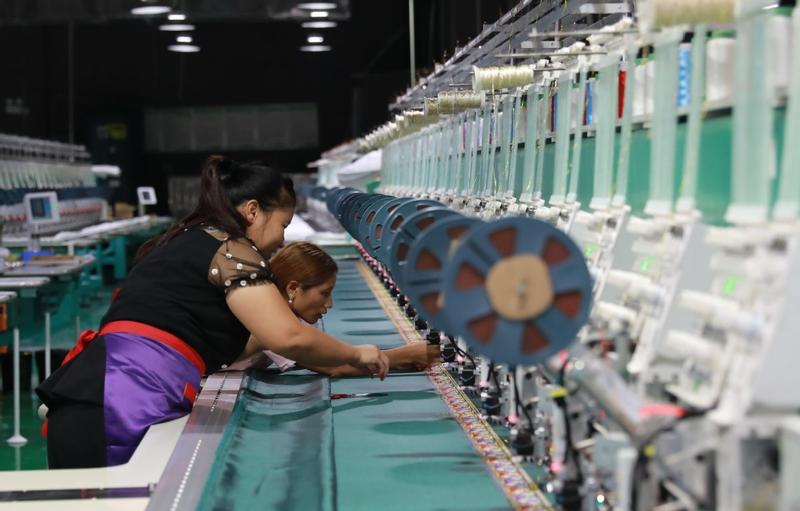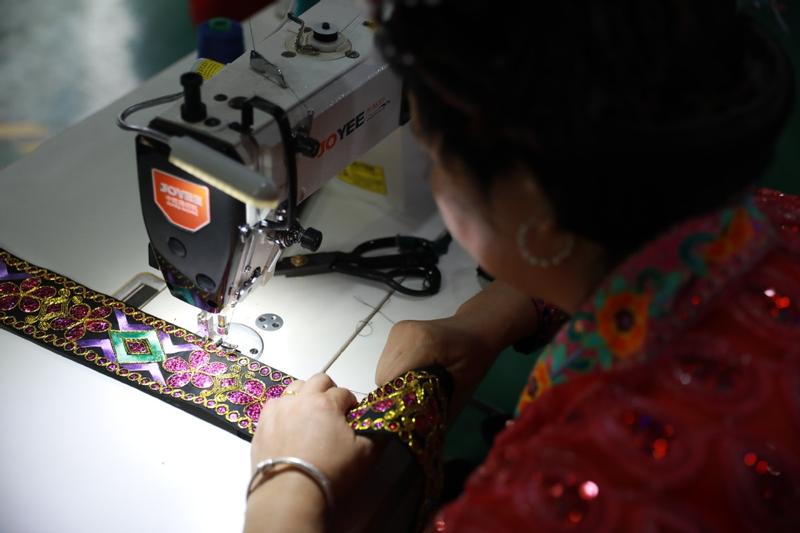 In this September 2020 file photo, employees work with embroidery machines at the workshop owned by Wei Zuying, a deputy to the 13th National People's Congress, in Congjiang county, Guizhou province. (YAO XU / CHINA DAILY)
In this September 2020 file photo, employees work with embroidery machines at the workshop owned by Wei Zuying, a deputy to the 13th National People's Congress, in Congjiang county, Guizhou province. (YAO XU / CHINA DAILY)
Wei Zuying, a native of Southwest China's mountainous Guizhou province and a deputy to the 13th National People's Congress, said embroidery is inherently part of the culture of the Miao ethnic group, and she hopes the skill can be passed down over generations.
Embroidery skills and folk songs of Miao and Dong ethnic groups need promotion by experts and scholars. More importantly, the younger generation needs to inherit and innovate their culture. It is a long-term and arduous task as many young people do not pay attention to such things or are not that interested in traditional culture.
Wei Zuying, deputy to the 13th National People's Congress
Wei, 40, an inheritor of an intangible cultural heritage designation for embroidery, started working at a clothing factory in Guangzhou, Guangdong province, two decades ago. She worked there for more than 10 years and was deeply impressed by the modern equipment and automation there, even as she was engaged in an activity traditionally reliant on manual labor.
In 2011, she returned to her hometown and bought a used automated embroidery machine. With an initial investment of 200,000 yuan (US$29,700), she opened her own embroidery workshop in Maan village, Congjiang county, Guizhou.
A niche has since developed for embroidery in Congjiang. Wei and other designers now create new templates every year, and she tends to blend traditional Miao patterns with modern styles. The factory has made it possible for impoverished women in the village to both work near home and increase their incomes.
ALSO READ: Horsetail embroidery's fresh twist turns a profit
Over the years, an entrepreneurial spirit has been growing in Maan-formerly a source of a great deal of migrant workers. Some former employees who worked at Wei's factory have even established their own factories and become their own bosses.
"Embroidery has become a major business in Maan. The streets are filled with the sound of embroidery machines, and everyone is rushing to and from work as they have a large number of orders to finish," Wei said.
"Compared with manual embroidery that requires time and patience, embroidery machines can help quickly complete large quantities of orders and meet demand from different customers. Despite the fact that we now use machines, traditional Miao embroidery culture remains the soul of these embroidered products," she said.
The national culture of the Miao ethnic group should not be hidden deep in the mountains and restricted by geography, but should be promoted to wider areas nationwide, Wei added.
In Maan, there is a traditional custom that when girls get married, they usually wear a new beautifully embroidered handmade dress, and they will later also wear it at major festivals. Thus, most girls in the village learn the skill from childhood, and embroidery has become an essential undertaking for most locals.
ALSO READ: Traditional embroidery helps embellish villagers' lives
"At the factory, embroiderers arrive daily and work with machines. Some with exceptional skills can work from home and be paid based on the number of pieces they produce. The combination of mechanical and manual embroidery ensures mass production and helps pass down skilled craftsmanship," Wei said.
Serving as a deputy to the 13th NPC, she hopes to help more women who live in impoverished conditions to master and inherit traditional embroidery skills and thus make a better living and enrich their lives. Inheritance and development of national culture is her focus as a deputy, and she has felt greater responsibility after taking the position of a national lawmaker.
During the annual two sessions in 2018, she put forward a proposal on how to transform the advantages of national culture into advantages of industrial growth.
Last year, she put forward proposals on building firefighting facilities in villages in less developed areas in Guizhou, and constructing a national highway to ease travel difficulties in mountainous regions.
 In this September 2020 file photo, an embroiderer sews patterns with a sewing machine on a traditional ribbon at Wei Zuying's factory in Congjiang county, Guizhou province. (YAO XU / CHINA DAILY)
In this September 2020 file photo, an embroiderer sews patterns with a sewing machine on a traditional ribbon at Wei Zuying's factory in Congjiang county, Guizhou province. (YAO XU / CHINA DAILY)
Most villages are now equipped with fire trucks and the highway has been opened for traffic, which provides a road to prosperity for villagers and their products, including embroidered pieces of course.
With the support of the local government, Wei set up another embroidery factory at a community in Congjiang in March. A large number of villagers moved to flats in town from their rural homes, and they received professional training before landing jobs as embroiderers.
Currently, China has nearly 9,500 companies engaged in making traditional folk costumes, with the number increasing steadily in recent years. More than 60 percent of the total are small and medium-sized enterprises, according to data from Tianyancha
They live above the factory, thus making it convenient for them to look after children.
The 6,000-square-meter workshop has 26 large-scale embroidery machines and 120 sewing machines. It mainly produces traditional clothing, shoes and silver ornaments unique to the Miao ethnic group. The products are sold to Guizhou, Guangdong, the Guangxi Zhuang autonomous region and other areas.
The community factory is expected to achieve annual output value of 10 million yuan, and it plans to pay 240 female employees a combined 5.8 million yuan a year, Wei said.
Besides a brick-and-mortar store in Congjiang that sells finished embroidered pieces, the factory also sells its products online through messaging app WeChat and mobile video app Kuaishou.
The average age of the factory workers is 50, and their minimum wage is set at 1,800 yuan a month, Wei said.
"Women who come from Congjiang have attained a certain degree of mastery in craftsmanship since they have been doing it for many years," said Yang Liuzhen, president of the women's federation of Meie community, Congjiang, who is responsible for the management of Wei's factory.
"Most women would like to find a stable job as an embroider. We give them embroidery training for about a week before they become skillful enough to do the work," Yang said.
ALSO READ: Yi woman stitches herself a better life through her embroidery skills
During the two sessions this year, what Wei cared about the most was how can younger generations better understand, inherit and develop national folk cultures.
"Embroidery skills and folk songs of Miao and Dong ethnic groups need promotion by experts and scholars. More importantly, the younger generation needs to inherit and innovate their culture. It is a long-term and arduous task as many young people do not pay attention to such things or are not that interested in traditional culture," Wei said.
Currently, China has nearly 9,500 companies engaged in making traditional folk costumes, with the number increasing steadily in recent years. More than 60 percent of the total are small and medium-sized enterprises, according to data from Tianyancha, a data company providing information on Chinese enterprises.
Guizhou has more than 2,100 related enterprises, accounting for the largest portion nationwide. Guizhou is followed by the Inner Mongolia autonomous region and Yunnan province.


